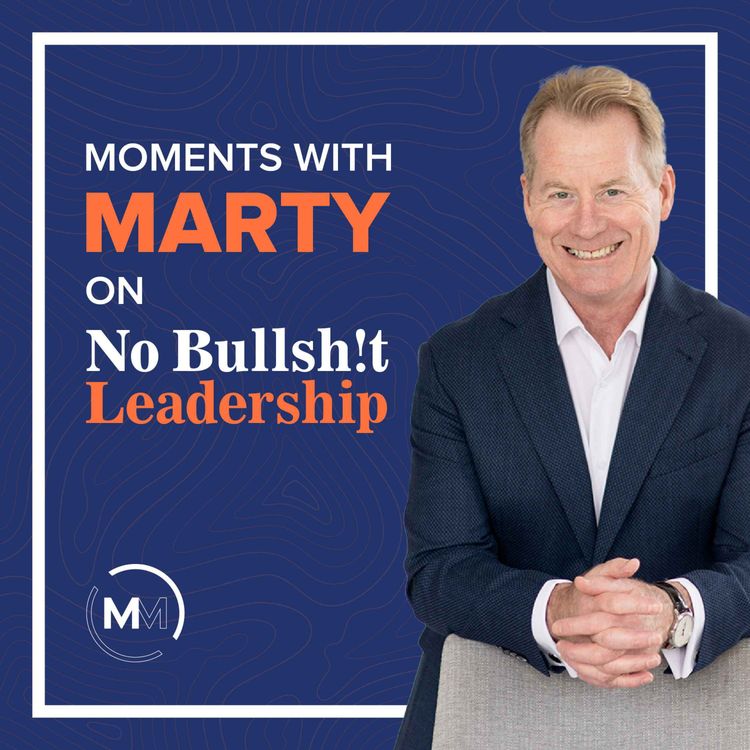Share

No Bullsh!t Leadership
Moment #60: Getting Help Without Breaking the Bank
Moment #60 // I’m a big believer in avoiding the problems that inevitably emerge when you become too isolated, or spend too much time cocooned in your own little world.
There’s no end to the number of consultants out there who hold themselves up as experts, and promise to make your business better in oh-so-many ways. How would you know which options are likely to give you real value for money, and which are likely to be an expensive waste of time?
The management consulting market is segmented quite clearly, but can still be quite difficult to navigate. In this Moment I give you a feel for its complexity, and a few rules of thumb for how to bring expertise into your organization, without breaking the bank.
You can take a deeper dive into these insights by listening to Ep.220: Management Consultants.
————————
FREE QUIZ: I’ve developed a 3-question quiz that’ll give you a free personalized podcast playlist tailored to where you are right now in your leadership career!
Click here to take the 30-second quiz now to get your on-the-go playlist
————————
You can connect with me at:
Website: https://www.yourceomentor.com
Facebook: https://www.facebook.com/yourceomentor
Instagram: https://www.instagram.com/yourceomentor
Linkedin: https://www.linkedin.com/in/martin-moore-075b001/
Youtube: https://www.youtube.com/@YourCEOMentor
————————
Our mission here at Your CEO Mentor is to improve the quality of leaders, globally.
👉 Doors are open for Leadership Beyond the Theory. Be the boss you wish you had.
🔗 Enroll now at leadershipbeyondthetheory.com
More episodes
View all episodes

Moment 156. How to Improve Results Without Working Harder
05:22|The fastest way to lift performance isn’t more effort. It’s ruthless focus on value. Cost and value are different. Knowing how to separate the two is essential.In this Moment, I identify the 6 biggest barriers to value capture, so that you can attack the problem at its core.Creating a sharper focus on the things that create value will equip your team to effortlessly deliver a massive performance uplift.If you want to take a deeper dive into how you can rapidly improve team performance, have a listen to Ep.261: Do You REALLY Understand Value?.————————Have you taken our free Leadership Blindspot test?✨ In just 5 minutes you’ll uncover the hidden leadership habits holding you back.Get your Blindspot Score and know exactly what to fix before it costs your career!TAKE THE FREE TEST HERE————————You can connect with me at:Website: https://www.yourceomentor.comFacebook: https://www.facebook.com/yourceomentorInstagram: https://www.instagram.com/yourceomentorLinkedin: https://www.linkedin.com/in/martin-moore-075b001/Youtube: https://www.youtube.com/@YourCEOMentor————————Our mission here at Your CEO Mentor is to improve the quality of leaders, globally.
Paying the Price of Leadership: 4 Hard Truths Every Leader Must Accept
19:23|It’s easy to talk about the benefits of leadership, but very few people talk about the cost of leadership. There’s a price to pay, and unless you’re willing to pay it, you’ll never be truly comfortable in a leadership role:You will have to make hard decisions that negatively affect people you care aboutYou will be disliked, despite your best attempts to do the best for the mostYou will be misunderstood, and won’t always have the opportunity to defend yourselfFor each of these costs, I’ll interpret it for the business leadership context, and give some examples of how it plays out. I’ll also give you four tips for embracing the cost, so that you willingly pay the price of leadership, rather than trying to bargain or avoid it.Links mentioned in this episode:YouTube link:Kirby Smart - The Cost of Great LeadershipMoments With Marty Spotify Link: Moment #151: 5 Steps to Reverse a Performance Slump LBT link: Leadership Beyond the TheoryWikipedia links: Kirby Smart————————Have you taken our free Leadership Blindspot test?✨ In just 5 minutes you’ll uncover the hidden leadership habits holding you back.Get your Blindspot Score and know exactly what to fix before it costs your career!TAKE THE FREE TEST HERE————————You can connect with me at:Website: https://www.yourceomentor.comFacebook: https://www.facebook.com/yourceomentorInstagram: https://www.instagram.com/yourceomentorLinkedin: https://www.linkedin.com/in/martin-moore-075b001/Youtube: https://www.youtube.com/@YourCEOMentor————————Our mission here at Your CEO Mentor is to improve the quality of leaders, globally.
Moment 155. 5 Steps to Reverse a Performance Slump
05:29|If your confidence has slipped lately, this 5-step reset could save your performance. Occasionally, for some unknown reason, you may experience a slump in performance: and it can seriously affect your confidence.How does something like this happen? And, more importantly, how do you dig yourself out of the hole?If you want to take a deeper dive into how you can quickly recognise a performance hiccup and rebuild your confidence, have a listen to Ep.236: The Mental Game of Leadership.————————Have you taken our free Leadership Blindspot test?✨ In just 5 minutes you’ll uncover the hidden leadership habits holding you back.Get your Blindspot Score and know exactly what to fix before it costs your career!TAKE THE FREE TEST HERE————————You can connect with me at:Website: https://www.yourceomentor.comFacebook: https://www.facebook.com/yourceomentorInstagram: https://www.instagram.com/yourceomentorLinkedin: https://www.linkedin.com/in/martin-moore-075b001/Youtube: https://www.youtube.com/@YourCEOMentor————————Our mission here at Your CEO Mentor is to improve the quality of leaders, globally.
384. 10 Ways To Make Your Success Inevitable
18:42||Season 1, Ep. 384Success isn’t accidental; it follows principles that most people prefer to ignore.In this episode, I show you how to focus on the things that really matter: the timeless principles that will make your success inevitable.Traditionally around this time, we produce an episode focused on the outlook for the year ahead but, heading into 2026, we decided to do something a little different.I'm going to focus on the success principles that will make a genuine difference. Your job is to distil the one or two that are most important to you, and work out how to embrace them in the coming year. There’s some work in this for you… it’s not just a casual listen. But I know you’re up for it! It will make ALL the difference to your mindset as you head into another year.————————FREE QUIZ: I’ve developed a 3-question quiz that’ll give you a free personalised podcast playlist tailored to where you are right now in your leadership career!Click here to take the 30-second quiz now to get your on-the-go playlist————————You can connect with me at:Website: https://www.yourceomentor.comFacebook: https://www.facebook.com/yourceomentorInstagram: https://www.instagram.com/yourceomentorLinkedin: https://www.linkedin.com/in/martin-moore-075b001/Youtube: https://www.youtube.com/@YourCEOMentor————————Our mission here at Your CEO Mentor is to improve the quality of leaders, globally.
Moment 154. Layoffs Done Right (Without Losing Your Best People)
05:06|How to execute layoffs decisively without damaging trust, morale, or talent. Termination for cause? Termination for convenience? Role redundancy?As a leader, you’ll sometimes have to face the difficult task of terminating someone’s employment. How can you do it without spooking your best people, and forcing an exodus of top talent?If you want to take a deeper dive into how you can pull out costs, without losing talent, have a listen to Ep.225: Handling Layoffs Competently.————————FREE QUIZ: I’ve developed a 3-question quiz that’ll give you a free personalized podcast playlist tailored to where you are right now in your leadership career!Click here to take the 30-second quiz now to get your on-the-go playlist————————You can connect with me at:Website: https://www.yourceomentor.comFacebook: https://www.facebook.com/yourceomentorInstagram: https://www.instagram.com/yourceomentorLinkedin: https://www.linkedin.com/in/martin-moore-075b001/Youtube: https://www.youtube.com/@YourCEOMentor————————Our mission here at Your CEO Mentor is to improve the quality of leaders, globally.
383. The 5 Leadership Episodes from 2025 That Actually Moved the Needle
19:20||Season 1, Ep. 383Most leadership content is consumed. Very little of it is used.In this end-of-year episode, we count down the 5 episodes from 2025 that genuinely changed how leaders think and act - not because they were popular, but because they were applied.This isn’t a highlight reel. It’s a practical breakdown of why these episodes resonated, what made them work, and how you can use the ideas immediately.From running better 1:1s, to building real team performance, to leading effectively inside toxic cultures, each episode on this list solved a problem leaders are actually facing right now.We unpack:Why clarity beats comfort in performance conversationsWhy leadership confidence comes from doing hard things, not avoiding themWhat high-performing teams really look like (and why most aren’t)How winning cultures are built under pressureHow to lead well when the environment around you isn’t healthyIf you’ve missed any of these episodes, or listened but didn’t fully apply them, this is your chance to go back and use them properly.Don’t treat this like entertainment, treat it like a toolbox.Lock in and revisit the episodes that moved the needle in 2025!For easy access, here are the episode links: 🔥 Top 5 Most Popular Episodes Released in 20251. Ep.354 – How to Lead in a Toxic Culture: Your Survival Guide2. Ep.344 – How to Build a Winning Team Culture (In Just 90 Days)3. Ep.355 – The New Rules for Building a High-Performing Team - Download the FREE diagnostic PDF for this one! 4. Ep.337 – How To Do Hard Things: 4 Strategies to Improve Leadership Resilience5. Ep.334 – The Perfect Ending for a 1:1 Meeting————————You can connect with me at:Website: https://www.yourceomentor.comFacebook: https://www.facebook.com/yourceomentorInstagram: https://www.instagram.com/yourceomentorLinkedin: https://www.linkedin.com/in/martin-moore-075b001/Youtube: https://www.youtube.com/@YourCEOMentor————————Our mission here at Your CEO Mentor is to improve the quality of leaders, globally.
Moment 153. What REALLY Makes You More Resilient?
05:44|Resilient leadership isn’t about toughing it out, it’s about staying calm under pressure. Every leader likes to think they’re highly resilient. But many lack composure in high-stress situations (and also the self-awareness to admit it).Resilience is about regulating your own behaviour. But if you’re a leader, the real acid test is whether you have the mental, emotional, and psychological strength to support your team, so that they remain as calm as you do.If you want to take a deeper dive into how you can achieve Grace Under Pressure faster, have a listen to Ep.228: Resilience Myths.————————FREE 5 DAY LEADERSHIP CHALLENGE: Want to boost your leadership capability? This challenge will start you down the path of improving your leadership confidence and skills—if you're willing to put in the work!Start the free 5 Day Leadership Challenge today: https://yourceomentor.com/challenge————————You can connect with me at:Website: https://www.yourceomentor.comFacebook: https://www.facebook.com/yourceomentorInstagram: https://www.instagram.com/yourceomentorLinkedin: https://www.linkedin.com/in/martin-moore-075b001/Youtube: https://www.youtube.com/@YourCEOMentor————————Our mission here at Your CEO Mentor is to improve the quality of leaders, globally.
382. The Career Strategy Most Leaders Don’t Have (2026 Edition)
09:26||Season 1, Ep. 382Your career already has a direction…the question is, did you choose it?In 2026, relying on hard work, loyalty, or good intentions isn’t enough. AI is reshaping roles, career paths are less protected, and the system you’re operating in has plans for you...whether you like them or not.In this annual Crush Your Career episode, we unpack why deliberate career strategy now matters more than ever, and why the leaders who continue to progress are the ones who stop reacting and start designing what comes next.If you want to stay relevant, valuable, and in control of your career trajectory, this episode sets the frame, and invites you to take part in the free Crush Your Career Challenge (2026 Edition).Are you actively driving your career…or letting it drift?Join the challenge now here!————————FREE QUIZ: I’ve developed a 3-question quiz that’ll give you a free personalised podcast playlist tailored to where you are right now in your leadership career!Click here to take the 30-second quiz now to get your on-the-go playlist————————You can connect with me at:Website: https://www.yourceomentor.comFacebook: https://www.facebook.com/yourceomentorInstagram: https://www.instagram.com/yourceomentorLinkedin: https://www.linkedin.com/in/martin-moore-075b001/Youtube: https://www.youtube.com/@YourCEOMentor————————Our mission here at Your CEO Mentor is to improve the quality of leaders, globally.
Moment 152. Are Leaders Better Than Managers?
04:52|Leadership vs management: why great leaders must also manage to make better decisions. While the debates about leadership and management continue to rage, the truth is that they’re intrinsically linked: they live on a continuum, in a spectrum of subtle gradients.You can’t be a great leader unless you’re a good manager. And the converse is also true: you can’t be a great manager unless you’re a good leader.It’s complete nonsense to portray leadership and management as inherently good or bad.If you want to take a deeper dive into how you can integrate your management and leadership skills, have a listen to Ep.267: Management v Leadership.————————FREE QUIZ: I’ve developed a 3-question quiz that’ll give you a free personalised podcast playlist tailored to where you are right now in your leadership career!Click here to take the 30-second quiz now to get your on-the-go playlist————————You can connect with me at:Website: https://www.yourceomentor.comFacebook: https://www.facebook.com/yourceomentorInstagram: https://www.instagram.com/yourceomentorLinkedin: https://www.linkedin.com/in/martin-moore-075b001/————————Our mission here at Your CEO Mentor is to improve the quality of leaders, globally.